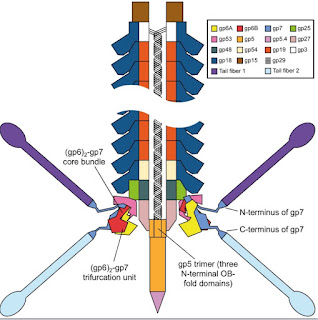Bacteria and bacteriophages utilize a rigid
tube-contractile sheath mechanism
for delivering proteins and DNA across the cell
envelope. Here we describe conserved features of these contractile assemblies
and propose their evolutionary pathway. The complexity of today’s systems is a
result of gene duplication and subsequent specialization of function.
Contractile
tail bacteriophages, or myobacteriophages, use a
sophisticated biomolecular structure to inject their genome into the bacterial
host cell. This structure consists of a
contractile sheath enveloping a rigid tube that is sharpened by a spike-shaped protein
complex at its tip. The spike complex forms the centerpiece of a baseplate complex
that terminates the sheath and the tube.
The baseplate anchors the tail to the target cell membrane
with the help
of fibrous proteins
emanating from it and triggers
contraction of the sheath. The contracting sheath drives the
tube with its spiky tip through the target cell membrane. Subsequently, the bacteriophage genome is
injected through the tube.
The structural transformation of
the bacteriophage T4
baseplate upon binding
to the host
cell has been
recently described in
near-atomic detail.


No hay comentarios:
Publicar un comentario
Nota: solo los miembros de este blog pueden publicar comentarios.